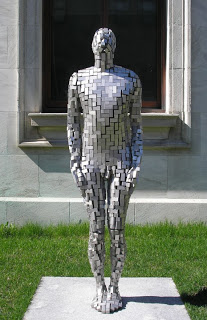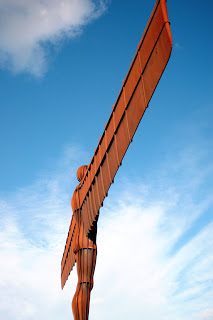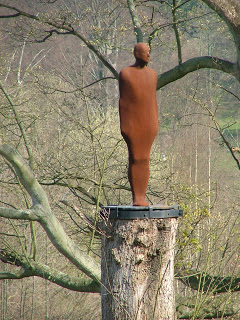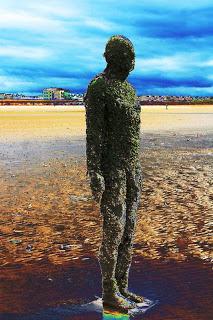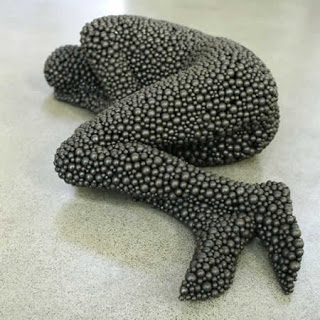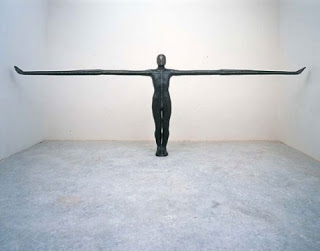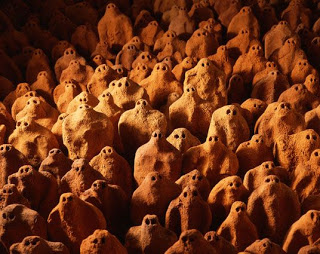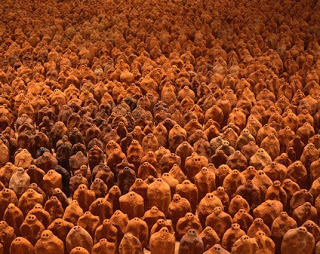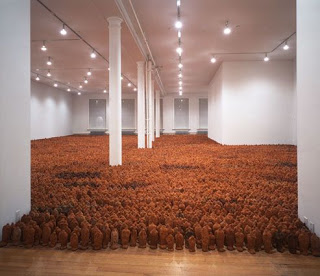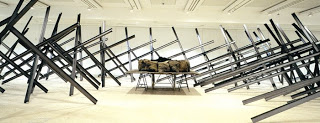29 Απριλίου 2009
Antony Gormley
Antony Gormley was born in London in 1950. Upon completing a degree in archaeology, anthropology and the history of art at Trinity College, Cambridge, he travelled to India, returning to London three years later to study at the Central School of Art, Goldsmiths College and the Slade School of Art.
Over the last 25 years Antony Gormley has revitalised the human image in sculpture through a radical investigation of the body as a place of memory and transformation, using his own body as subject, tool and material. Since 1990 he has expanded his concern with the human condition to explore the collective body and the relationship between self and other in large-scale installations like Allotment, Critical Mass, Another Place, Domain Field, and Inside Australia. His recent work increasingly engages with energy systems, fields and vectors, rather than mass and defined volume, evident in works like Clearing, Blind Light, Firmament and Another Singularity.
Antony Gormley’s work has been exhibited extensively, with solo shows throughout the UK in venues such as the Whitechapel, Tate and the Hayward galleries, the British Museum and White Cube, and internationally at museums including the Louisiana Museum in Humlebaek, the Corcoran Gallery of Art in Washington DC, the Irish Museum of Modern Art in Dublin, and the Kölnischer Kunstverein in Germany. Blind Light, a major solo exhibition of his work, was held at the Hayward Gallery in 2007.
He has participated in major group shows such as the Venice Biennale and the Kassel Documenta 8. His Field has toured America, Europe and Asia. Angel of the North and, more recently, Quantum Cloud on the Thames in Greenwich are amongst the most celebrated examples of contemporary British sculpture. One of his key installations, Another Place, is to remain permanently on display at Crosby Beach, Merseyside.
He was awarded the Turner Prize in 1994 and the South Bank Prize for Visual Art in 1999 and was made an Order of the British Empire (OBE) in 1997. In 2007 he was awarded the Bernhard Heiliger Award for Sculpture. He is an Honorary Fellow of the Royal Institute of British Architects, Trinity College, Cambridge and Jesus College, Cambridge, and has been a Royal Academician since 2003.
Field
(1991 – 2003)
From the beginning I was trying to make something as direct as possible with clay: the earth.
I wanted to work with people and to make a work about our collective future and our responsibility for it. I wanted the art to look back at us, its makers (and later viewers), as if we were responsible – responsible for the world that it (the work Field) and we were in. I have made it with help five times in different parts of the world.
The most recent is from Guangzhou, China, and was exhibited in Guangzhou, Beijing, Shanghai and Chongqing in 2003. It’s made from one hundred and twenty-five tons of clay energised by fire, sensitised by touch and made conscious by being given eyes.
The 200,000 body-surrogates completely occupy the space in which they are installed, taking the form of the building and excluding us, but allowing visual access.
It is always seen from a single threshold. The dimensions of the viewing area are equivalent to no less than one sixth of the total floor area of the piece. This viewing area is completely empty.
The viewer then mediates between the occupied and unoccupied areas of a given building. I like the idea of the physical area occupied being put at the service of the imaginative space of the witness.
Makers’ Instructions
I gave these instructions to the makers:
Take a hand-size ball of clay, form it between the hands, into a body surrogate as quickly as possible. Place it at arm’s length in front of you and give it eyes.
It was important that it was through the repeated action of touching, forming, placing apart from the body and making conscious, that each person found their own form. The extraordinary thing was the distinctiveness of the forms that were found.
Angel of the North
Gateshead (1998)
Is it possible to make a work with purpose in a time that demands doubt? I wanted to make an object that would be a focus of hope at a painful time of transition for the people of the north-east, abandoned in the gap between the industrial and the information ages.
The work is made of corten steel, weighs 200 tonnes and has 500 tonnes of concrete foundations. The mound near the A1 motorway which was the designated site of the sculpture was made after the closure of the Lower Tyne Colliery, out of the destroyed remains of the pithead baths. It is a tumulus marking the end of the era of coal mining in Britain.
The Angel resists our post-industrial amnesia and bears witness to the hundreds and thousands of colliery workers who had spent the last three hundred years mining coal beneath the surface.
The scale of the sculpture was essential given its site in a valley that is a mile and a half a mile wide, and with an audience that was travelling past on the motorway at an average of 60 miles an hour.
The exo-skeleton seemed the best solution for transforming a self-supporting fibreglass and lead structure into an object 10 times life-size, or 20 m high. It uses the Tyneside engineering vernacular of ships and the Tyne Bridge, to produce a strong structure that would withstand the prevailing south-easterly winds. This has the added advantage of giving the form a strong surface articulation that deals equally well with volume and light.
We made a series of models to work out how this was going to work: the challenge was to transfer a rib structure that radiates from a central axis in the bodyform onto the wings, and the solution was to have an increasing distance between the ribs, suggesting a broadcasting of energy.
The work stands, without a spolight or a plinth, day and night, in wind, rain and shine and has many friends. It is a huge inspiration to me that the Angel is rarely alone in daylight hours, and as with much of my work, it is given a great deal through the presence of those that visit it.
12 Απριλίου 2009
//www.youtube.com/get_playerΜ’αυτό το βίντεο θέλησα να παρουσιάσω έναν απο τους τρόπους με τους οποίους εκδηλώνει ένας άνθρωπος το φαινόμενο της συναισθησίας… Η δημιουργία του έγινε σε πρόγραμμα δημιουργίας τρισδιάστατων αντικειμένων (3D Max) και η κίνηση που του προσαρμόστηκε προέρχεται απο εργαλεία του ίδιου προγράμματος.
Το θέμα που διάλεξα να προβάλλω είναι και ο τρόπος με τον οποίο εκδηλώνεται σε μένα η συναισθησία. Μου δίνει την δυνατότητα να ταυτίζω τους αριθμούς και κάποιες λέξεις, των οποίων η ερμηνεία δεν έχει να κάνει με οτιδήποτε που έχει δική του εικόνα, με χρώματα. Για παράδειγμα η λέξη ήλιος συνδιάζεται αυτόματα με το κίτρινο ή πορτοκαλί χρώμα όπως και η λέξη αίμα με το κόκκινο, αντίθετα οι λέξεις αυτοπεποίθηση, πόνος, ελπίδα κ.ο.κ ως έννοιες δεν έχουν εικόνα έτσι ο κάθε άνθρωπος τις εκλαμβάνει με διαφορετικό και υποκειμενικό τρόπο κάθε φορα. Ο δικός μου τρόπος είναι “χρωματικός”.
9 Απριλίου 2009
8 Απριλίου 2009
SIGNATURE
KAI NAI….Η ΥΠΟΓΡΑΦΗ ΣΟΥ ΕΧΕΙ ΣΗΜΑΣΙΑ…ΕΝΑ ΑΠΟ ΤΑ ΠΙΟ ΩΡΑΙΑ ΑΝΙΜΑΤΙΟΝ ΠΟΥ ΕΧΩ ΔΕΙ(ΜΟΥΣΙΚΗ ΦΟΒΕΡΗ…)
http://www.youtube.com/watch?v=ehKA8vi2EbE

